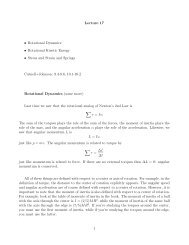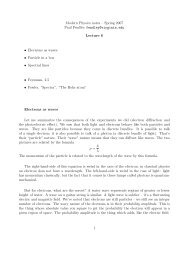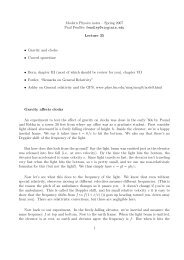Modern Physics notes Paul Fendley fendley@virginia.edu Lecture 6 ...
Modern Physics notes Paul Fendley fendley@virginia.edu Lecture 6 ...
Modern Physics notes Paul Fendley fendley@virginia.edu Lecture 6 ...
You also want an ePaper? Increase the reach of your titles
YUMPU automatically turns print PDFs into web optimized ePapers that Google loves.
uncertainty is of order h/4π. For this reason, and others I’ll mention soon, physicists usually<br />
use the constant which is merely Planck’s constant divided by 2π:<br />
≡ h<br />
2π = 1.055 × 10−34 J · s<br />
The symbol ≡ means “is defined as”. (One reason is that it’s easier to say “h-bar” than “Planck’s<br />
constant”.) So to get the same numerical answer as Feynman, let’s say the momentum is of order<br />
/a instead of h/a. This is a hand-waving argument anyway!<br />
So now let’s look at the energy of the hydrogen atom. The charge on the nucleus is just −e,<br />
and the charge of the electron is e. (We define e to be negative; the answers will depend only on<br />
e 2 , so this definition doesn’t affect the results, a useful check.) In addition to the kinetic energy,<br />
there’s an electrostatic potential energy coming from the two charges being a distance a apart.<br />
The total energy is therefore about<br />
E =<br />
2<br />
2Ma −<br />
e2<br />
2 4πɛ 0 a<br />
The minus sign in the second term is because the electron and the nucleus are attractive. Notice<br />
that as a decreases, we lower the potential energy, but we also increase the kinetic energy (the<br />
uncertainty principle means that cramming a particle into a smaller box increases its energy).<br />
The value of a is determined by finding the minimum of this energy The reason is that in<br />
the absence of any external sources of energy, it’s possible to get rid of energy by say emitting<br />
light, but there’s no way of getting new energy. Thus the system will settle down into its lowest<br />
energy state, and then be stable. To find this minimum value of energy, we find where dE/da = 0.<br />
Precisely, at the minimum a = a 0 , we have<br />
Solving for a 0 gives<br />
a 0 = 4πɛ 0 2<br />
m e e 2 =<br />
0 = dE<br />
da = − 2<br />
+ e2<br />
m e a 3 0 4πɛ 0 a 2 0<br />
(1.055 × 10 −34 ) 2<br />
(8.988 × 10 9 )(9.106 × 10 −31 )(1.602 × 10 −19 ) 2 m = .529 × 10−10 m<br />
So the size of the hydrogen atom is about 10 −10 m, which is called an angstrom. (People today<br />
tend to use nm = 10 −9 m instead of angstroms.) Using a simple hand-waving argument, we know<br />
the approximate size of an atom! (note that this factor of 2π Feynman is sloppy on changes the<br />
answer by a factor of 40, because it’s squared!)<br />
To find the energy of this electron at this minimum, we can now plug our value of a 0 back<br />
into the expression for E. After a little algebra, we get<br />
e2<br />
E = − = −13.6 eV<br />
8πɛ 0 a 0<br />
2











